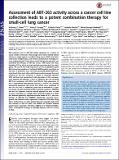Assessment of ABT-263 activity across a cancer cell line collection leads to a potent combination therapy for small-cell lung cancer
Author(s)
Faber, Anthony C.; Costa, Carlotta; Dastur, Anahita; Gomez-Caraballo, Maria; Robbins, Rebecca; Wagner, Bethany L.; Rideout, William M.; Jakubik, Charles T.; Ham, Jungoh; Edelman, Elena J.; Ebi, Hiromichi; Yeo, Alan T.; Hata, Aaron N.; Song, Youngchul; Patel, Neha U.; March, Ryan J.; Tam, Ah Ting; Milano, Randy J.; Boisvert, Jessica L.; Hicks, Mark A.; Elmiligy, Sarah; Malstrom, Scott E.; Rivera, Miguel N.; Harada, Hisashi; Windle, Brad E.; Ramaswamy, Sridhar; Benes, Cyril H.; Engelman, Jeffrey A.; Farago, Anna; Malstrom, Scott E.; Jacks, Tyler E; ... Show more Show less
DownloadFaber-2015-Assessment of ABT-26.pdf (1.578Mb)
PUBLISHER_POLICY
Publisher Policy
Article is made available in accordance with the publisher's policy and may be subject to US copyright law. Please refer to the publisher's site for terms of use.
Terms of use
Metadata
Show full item recordAbstract
BH3 mimetics such as ABT-263 induce apoptosis in a subset of cancer models. However, these drugs have shown limited clinical efficacy as single agents in small-cell lung cancer (SCLC) and other solid tumor malignancies, and rational combination strategies remain underexplored. To develop a novel therapeutic approach, we examined the efficacy of ABT-263 across >500 cancer cell lines, including 311 for which we had matched expression data for select genes. We found that high expression of the proapoptotic gene Bcl2-interacting mediator of cell death (BIM) predicts sensitivity to ABT-263. In particular, SCLC cell lines possessed greater BIM transcript levels than most other solid tumors and are among the most sensitive to ABT-263. However, a subset of relatively resistant SCLC cell lines has concomitant high expression of the antiapoptotic myeloid cell leukemia 1 (MCL-1). Whereas ABT-263 released BIM from complexes with BCL-2 and BCL-XL, high expression of MCL-1 sequestered BIM released from BCL-2 and BCL-XL, thereby abrogating apoptosis. We found that SCLCs were sensitized to ABT-263 via TORC1/2 inhibition, which led to reduced MCL-1 protein levels, thereby facilitating BIM-mediated apoptosis. AZD8055 and ABT-263 together induced marked apoptosis in vitro, as well as tumor regressions in multiple SCLC xenograft models. In a Tp53; Rb1 deletion genetically engineered mouse model of SCLC, the combination of ABT-263 and AZD8055 significantly repressed tumor growth and induced tumor regressions compared with either drug alone. Furthermore, in a SCLC patient-derived xenograft model that was resistant to ABT-263 alone, the addition of AZD8055 induced potent tumor regression. Therefore, addition of a TORC1/2 inhibitor offers a therapeutic strategy to markedly improve ABT-263 activity in SCLC.
Date issued
2015-03Department
Koch Institute for Integrative Cancer Research at MITJournal
Proceedings of the National Academy of Sciences
Publisher
National Academy of Sciences (U.S.)
Citation
Faber, Anthony C., Anna F. Farago, Carlotta Costa, Anahita Dastur, Maria Gomez-Caraballo, Rebecca Robbins, Bethany L. Wagner, et al. “Assessment of ABT-263 Activity Across a Cancer Cell Line Collection Leads to a Potent Combination Therapy for Small-Cell Lung Cancer.” Proc Natl Acad Sci USA 112, no. 11 (March 3, 2015): E1288–E1296.
Version: Final published version
ISSN
0027-8424
1091-6490